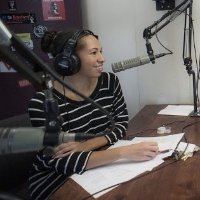Media Savvy Social Work Course
Alyssa Lotmore is the Assistant Director and Coordinator of Baccalaureate Field Education in the School of Social Welfare at the University at Albany, and the co-host of The Social Workers Radio Talk Show. In this blog post, she discusses her media savvy social work course. For student perspective on Ms. Lotmore’s course, read this blog post by Dottie-Jean Turenne.
When I tell my social work colleagues or students that I am a co-host of a live Social Work radio show, there is always that pause. It takes a minute for people to process the idea of a social worker using the radio as a means to advocate and raise awareness, even seasoned social workers. Typically, a degree in social work trains a practitioner to work individually with clients or organize communities. Even though coursework may briefly note that we can use media, particularly social media, to ignite change and share knowledge, there are few examples that shows us how to use such methods.
The goal of the Social Workers Radio Talk Show is to have students, faculty, and alumni on as co-hosts and guests to speak about social work trends and current practices provided by social workers. As I began to interview a variety of guests on the live show, I realized that even though they were conducting interesting research and/or had wonderful experiences to share, they struggled to translate that knowledge and expertise to the listeners in a clear, concise and engaging way. The use of social work jargon, filler words (i.e. ‘like’, ‘um’), unorganized content, and sounding flat were just a few of the issues that caused listeners to disengage. That led me to the idea of our Media Savvy Social Work Course, which teaches beneficial skills to social work students about seeing the public as the client and using the media to reach those who may never had considered seeing or using a social worker. The communication skills learned in this course are valuable to students who may never be on air. For example, when students learn to how to host a live radio show, they are learning how to speak with potential funders regarding why they should donate to an agency, effectively communicate with community members about how policies will affect them, and explain new client interventions to coworkers.
The goals of the course, which debuted in summer of 2014, are to have students become more comfortable using the medium of radio to get out a defined message, and to have the opportunity to practice the skills in an educational setting that allowed self and peer critique, as well as instructor feedback. Students use the Internet radio platform Blog Talk Radio to record and practice their skills. . There are many other ways to record shows; however, I liked how this site had a virtual board in which students could call in as guests, just as if you were in a real radio station. Students conduct multiple practice shows with classmates, switching roles as the host and guest. After each show, which always focuses on a social work topic, students listen to their own show and write a self-critique of their performance along with a journal self-reflection on the experience. Students also post their show, along with a creative promotional piece, on our learning management system so that other classmates can listen and provide a peer critique. After completing a few practice shows, students are then ready to conduct their final project in which they choose a social work topic and interview three guests regarding that topic. For example, if the topic was Veteran PTSD they may interview a Social Worker at the VA Hospital for the educational component, a Veteran for the personal story, and a case manager for Veterans who could give insight to available resources. This project is shared with the class, but can be made public and played on-air if it is a strong piece and consent is given from all who participated. Not only can students practice their own radio skills, but also learn new content by listening to the interviews of classmates. Click here to hear about how one student benefited from this media savvy social work course.
If you are thinking about incorporating these ideas into a similar course or even an assignment, consider the following tips for instructors:
1. Being recorded and having to share knowledge about social work can cause student anxiety. Start with a short 5-minute practice show where students can ‘get their feet wet’ and test out the equipment.
2. Allow students to chose their own topics. This creates diversity among assignments and allows students to learn about new topics when listening to classmates’ shows.
3. Give multiple opportunities for students to practice. This is not a skill that can be learned by reading a book. Students need to conduct several practice shows to improve and gain confidence.
4. Allow creativity. Students should come up with catchy show titles, let their personality shine through their work, and create promotional pieces that draw potential listeners in. Be sure to have guidelines, but do not make the requirements so rigid that students cannot make segments their own.
More information about the radio or the course, please visit our website at: www.albany.edu/the-social-workers.
How to cite this post:
Lotmore, A. (2015, May 19).Media Savvy Social Work Course[Blog Post]. Retrieved from https://laureliversonhitchcock.org/2015/05/19/media-savvy-social-work-course/.



